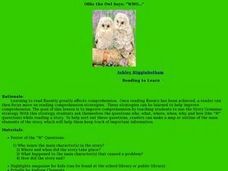Student Handouts
The Five W's and How
Here is a great graphic organizer for ensuring that young researchers and writers cover all their bases when brainstorming a topic by considering the five W's (who, what, where, when, and why) and how.
Curated OER
Creative Problem Solving: Using the 5 W's (Who, What, Where, When, Why)
Third graders assimilate the use of the 5 W's (Who, What, Where, When, Why) when solving problems that are presented in literature and in real life situations. They use common fairy tales to solve problems that might arise at home or...
Curated OER
"It's All About Grandma Chic": Reading Informational Text
This New York Times "Learning Network" exercise on reading informational text poses 6 questions about a high-interest article on teen fashion. The article meant to be review with is resource, "More than meets the iPhone Lens", is rather...
Curated OER
On the Dots
If you want your class to practice reading informational texts and answering related questions, this short exercise from The New York Times' "Learning Network" might be helpful. It includes an article on Dippin' Dots and uses...
Curated OER
"Every Block, Every Borough"
From the New York Times Learning Network series, this learning exercise poses 10 questions on an article entitled, "Leaving His Footprint on the City" about a man planning to walk every street in all five New York boroughs. The prompts...
Curated OER
Star 5 W's
In this 5 W's activity, students identify key elements from a book they have read: who, what, where, why, when. Students write details in the five points of a star and illustrate the book in the center.
Curated OER
The 5 W's
Examine how to answer who, what, when, where, and why when reading text. Young writers listen to the story Skeleton Hiccups, and as a class answer and discuss the five W's. Independently they read the story silently, and write the...
Curated OER
Ollie the Own Says: WHO
Scholars examine the strategy of making a story map or outline to identify the main elements of a story. They discuss the who, what, where, when, why, and how of a story, in an outline form. As a class they read a short story, answer the...
EngageNY
The Five W’s
Let's take the big W. Scholars analyze the model newspaper article Sandy wreaks havoc across Northeast; at
least 11 dead and look to answer who, what, when, where, and why. They work in groups of three to complete a Five W’s web...
Tompson Solutions
Be a Reporter (The 5 W's and an H)
Teach your class how to investigate research sources. You can start out with this presentation, which lays out a easy strategy for asking questions and taking down answers that cover the important information.
Curated OER
Question words, question marks
Practice the five W's and question marks with a fun grammar worksheet. After copying the words who, what, where, when, why, and how, kindergartners fill the words into various questions. For extra practice, have kids come up with their...
Curated OER
The 5 W's of Reading
Primary young scholars will use the five "W" questions for reading comprehension as they read silently to themselves so that they can understand and remember what they have read. They then read The Velveteen Rabbit aloud, discussing the...
Curated OER
Comprehending Through Questioning
Elementary schoolers observe and apply a variety of reading comprehension strategies. They silently read a passage out of their science textbook, and discuss answering the who, what, where, when, and how of the text. In small groups they...
Curated OER
Where the Books Are
The news is full of interesting stories and ideas shared in an informational style. Readers use the provided who, what, when, where, and why questions as they explore an article about a man who is passionate about archiving physical...
Curated OER
Build Masters: Identifying Details
Find key details in books using this note card strategy. Each reader gets six cards with the classic who, what, where, when, why, and how detail prompts. After they read the book, they choose a card and locate a key detail answering the...
Curated OER
A 'Stone of Hope'
Kids uncover the who, what, when, where, and why regarding the dedication of the Martin Luther King National Memorial. They read the provided New York Times article and then answer each of the 10 comprehension questions.
Curated OER
The Start of a New Era for Roman Catholics
Read all about it! Check out this article from the New York Times. Kids read about changes made to the wording used in Catholic Mass. They consider these changes by responding to each of the 10 related questions that ask, who, what,...
Curated OER
Pass This Jobs Bill
It seems that print media is slowly being replaced by electronic versions. Get your kids reading the New York Times e-style. They'll read the provided article entitled, "Pass This Jobs Bill" then answer six comprehension questions. Two...
Curated OER
Hip-Hop History and the Beastie Boys
So what about those Beastie Boys? Kids read a New York Times article relating the history of hip-hop and rap icons the Beastie Boys. They then answer eleven who, what, when, where, and why questions about the text they read.
Curated OER
Fun, and Risks, at the Beach in Tel Aviv
After reading the article "Fun, and Risks, at the Beach in Tel Aviv," learners consider eight related questions. They'll answer who, what, when, where, why, and how about the risks several Palestinian women took as they snuck over the...
Curated OER
Throwing, Passing and Signing
Football players break stereotypes by taking sign language classes to fulfill university language requirements. Learners read this article, then respond to six comprehension questions that ask who, what, when, where, how, and why.
Curated OER
Christie Will Not Run for President
Readers answer eight who, what, when, why, and where questions as they read this New York Times article. They peruse the article to learn about Chris Christie and the 2012 presidential race. Next, they answer the related comprehension...
Curated OER
The State of "No Child Left Behind"
Your class can read about the changes Obama considered making to Bush's No Child Left Behind Act. After reading the article, pupils answer 13 questions that ask, who, what, when, where, and why.
Curated OER
Taking Stock Before Iowa
As scholars take in the constant ambush of current events, help them develop media literacy skills by extracting important details from hard news articles. This story from December 2011 presents information on the Republican primaries...

























